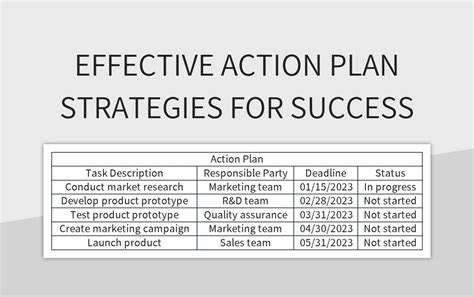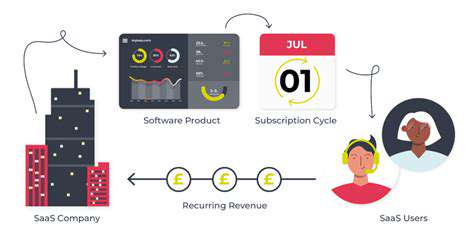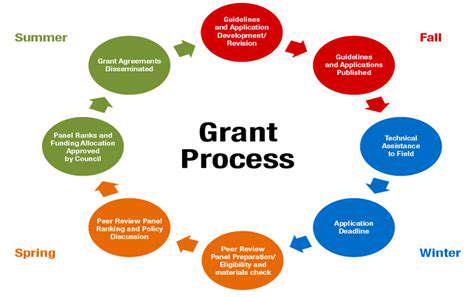How to Write a Persuasive Business Proposal
Defining Your Scope and Target Audience
Understanding Your Project's Boundaries
Clearly defining the scope of your project is crucial for a persuasive business proposal. This involves outlining the specific goals, deliverables, and timelines. A well-defined scope prevents misunderstandings and ensures that the project stays focused and within budget. Without a clear scope, your proposal risks becoming vague and unfocused, making it less compelling to potential investors or stakeholders. Thoroughly researching and documenting the project's parameters, including any limitations or constraints, is essential for a robust and realistic proposal.
Consider the specific tasks and resources required for each phase of the project. Detailing these elements helps demonstrate your understanding of the project's complexity and your ability to manage it effectively. This meticulous approach to defining the scope also allows you to accurately estimate the project's cost and timeline, which are critical factors in assessing its viability and potential return on investment.
Identifying Your Ideal Client
Knowing who you're trying to persuade is essential for crafting a compelling business proposal. Understanding your target audience's needs, pain points, and motivations allows you to tailor your proposal to resonate with them. A proposal that speaks directly to the concerns and aspirations of the intended recipients is far more likely to be persuasive. Conduct thorough research into your target audience's industry, values, and decision-making processes. This enables you to craft a proposal that aligns with their expectations and interests.
Analyzing the Competition
A successful business proposal differentiates itself by acknowledging and addressing the competition. Researching the offerings and strategies of competitors provides valuable insights into the market landscape. This research allows you to highlight the unique value proposition of your project and demonstrate why it is superior to existing options. Analyzing the competition's strengths and weaknesses empowers you to position your proposal as the more attractive and effective solution.
Understanding the competitive landscape helps you identify potential challenges and develop strategies to overcome them. This proactive approach to competitor analysis allows you to effectively address concerns and showcase the advantages of your project in a persuasive and convincing manner. It also allows you to adjust your proposal to position it as the best option in the market.
Forecasting Financial Implications
A strong business proposal incorporates a clear financial projection. This involves presenting realistic estimations of costs, revenues, and potential returns. Detailed financial projections demonstrate a thorough understanding of the project's financial implications and help potential investors assess its viability. This is an essential part of the proposal, allowing decision-makers to evaluate the potential return on investment and its alignment with their financial goals.
Clearly outlining the budget, including projected expenses for personnel, materials, and other resources, is critical. This transparency builds trust and allows stakeholders to assess the financial soundness of the proposed project. In addition to cost projections, include projected revenue streams and a clear explanation of how the project will generate returns.
Structuring Your Proposal for Maximum Impact

Understanding the Maxi Project Scope
Defining the scope of your Maxi project is crucial for its success. This involves clearly outlining the project's objectives, deliverables, and the boundaries within which it will operate. A well-defined scope minimizes the risk of scope creep, which can lead to delays and budget overruns. Understanding the project's goals from the outset helps you allocate resources effectively and manage expectations.
Thorough research and analysis of the Maxi project's potential impact and limitations are vital. This includes considering the potential risks and challenges that might arise during the project lifecycle. This early assessment allows for proactive planning and risk mitigation strategies.
Developing a Comprehensive Timeline
Creating a realistic timeline is essential for managing the Maxi project effectively. This involves breaking down the project into smaller, manageable tasks and estimating the time required for each. A detailed timeline helps to keep the project on track and allows for proactive adjustments if needed.
Consider all potential dependencies and milestones to ensure that the timeline is accurate and achievable. This approach helps in maintaining transparency and accountability throughout the project's lifespan.
Allocating Resources Effectively
Efficient resource allocation is vital for a successful Maxi project. This includes identifying the necessary personnel, equipment, and materials, and ensuring that these resources are available at the appropriate times. Proper resource management prevents bottlenecks and delays, ultimately contributing to the project's timely completion.
A thorough budget analysis should be incorporated into the resource allocation plan. This will ensure the project stays within budget constraints and allows for adjustments as needed.
Detailing Key Performance Indicators (KPIs)
Establishing clear KPIs is essential for measuring the success of the Maxi project. These indicators provide a quantifiable way to track progress and identify areas needing attention. Defining these KPIs upfront helps in evaluating the project's effectiveness and identifying any deviations from the planned trajectory.
Tracking KPIs allows for timely adjustments to ensure the project stays on track toward achieving its goals. Thorough monitoring and analysis of these KPIs provide crucial feedback for continuous improvement.
Presenting a Robust Budget Plan
A comprehensive budget plan is paramount for the Maxi project's financial sustainability. This plan should detail all anticipated costs, from personnel expenses to material procurement and operational overheads. Detailed budgeting ensures that the project stays within the allocated budget and avoids potential financial constraints.
Thorough cost analysis and contingency planning are crucial elements of a robust budget plan. This allows for flexibility and preparedness in case of unforeseen expenses.
Addressing Potential Risks and Mitigation Strategies
Anticipating and addressing potential risks is crucial for the success of the Maxi project. This involves identifying potential challenges and developing strategies to mitigate their impact. By proactively addressing potential risks, you can minimize disruptions and maintain project momentum.
A comprehensive risk assessment should be performed to identify potential threats and develop appropriate mitigation strategies. This includes evaluating the probability and potential impact of each risk.
Highlighting Your Value Proposition and Competitive Advantages
Understanding Your Target Audience
To effectively highlight your value proposition, you must first deeply understand your target audience. This involves more than just demographics; it's about identifying their pain points, needs, desires, and motivations. What problems are they trying to solve? What are their aspirations? Conducting thorough market research, analyzing customer feedback, and engaging in user interviews are crucial steps in gaining this crucial insight. Only then can you tailor your message to resonate with their specific circumstances and address their unique concerns.
Knowing their current solutions and frustrations will allow you to position your product or service as a superior alternative. This deep understanding will inform every aspect of your value proposition, from the language you use to the features you emphasize.
Defining Your Unique Value Proposition
Your unique value proposition (UVP) is the concise statement that clearly articulates the benefit your product or service provides to your target audience. It should highlight what makes you different and better than the competition. Avoid generic statements, instead focus on the specific advantages your offering provides over existing solutions. For example, instead of saying We offer quality products, articulate how your quality translates to a specific benefit for the customer, like Our meticulously crafted products are built to last a lifetime, ensuring you never have to replace them.
Highlighting Your Competitive Advantages
Identifying and clearly communicating your competitive advantages is critical. This involves scrutinizing your competitors' offerings and pinpointing where you excel. Do you have a superior product design, a more efficient process, or a more supportive customer service team? Highlighting these strengths, along with quantifiable results, will give potential customers concrete reasons to choose you over the competition. Emphasize how your advantages directly address the pain points you identified in your target audience research.
Demonstrating Measurable Results
Back up your claims with quantifiable results. Instead of simply stating that your product is effective, show how it has helped others. Include case studies, testimonials, and data to support your assertions. For example, if you claim to increase efficiency, provide specific numbers illustrating the improvement in productivity. Quantifiable results add credibility and build trust with potential customers.
Crafting a Compelling Narrative
Beyond features and benefits, crafting a compelling narrative that resonates with your target audience is key. This means weaving a story that connects with their emotions and aspirations. What is the story behind your company? What values do you uphold? Why should they choose you over others? A narrative provides context and builds an emotional connection that transcends the purely functional aspects of your product or service.
Communicating Your Value Effectively
The way you communicate your value proposition and competitive advantages is just as important as the content itself. Use clear, concise language and avoid jargon. Ensure your message is consistent across all platforms, from your website and marketing materials to your social media presence. A strong visual identity and engaging content will help reinforce your message and make it memorable.
Creating a Compelling Narrative and Visual Appeal
Crafting a Compelling Narrative
A compelling narrative is the cornerstone of any persuasive business writing. It's not just about presenting facts and figures; it's about weaving a story that resonates with your audience, connecting with their emotions, and ultimately driving them towards your desired action. Think about the stories you remember most vividly – they likely involved characters, conflicts, and a resolution. Employing this storytelling structure in your business writing can make your message more memorable and impactful, allowing your readers to see themselves within the narrative and understand the value proposition on a deeper level.
Understanding Your Audience
Before you begin crafting your narrative, it's crucial to understand your target audience. What are their needs, desires, and pain points? What motivates them? Conducting thorough research, analyzing market trends, and engaging in direct audience interaction will provide valuable insights into their perspectives. Understanding your audience will allow you to tailor your narrative to resonate with their specific concerns and aspirations. This empathy is critical for persuasive writing.
Developing a Strong Visual Appeal
Visual elements play a vital role in enhancing the impact of your message. Images, charts, graphs, and even videos can make your narrative more engaging and easier to comprehend. Select visuals that are relevant to your message, high-quality, and professional in their presentation. Visuals can reinforce your narrative, providing a complementary layer of information and making your content more accessible and understandable.
Utilizing Strong Keywords and Concise Language
Clear and concise language is essential for effective communication. Avoid jargon and overly technical terms that might confuse or alienate your audience. Employing strong keywords that resonate with your target audience will improve search engine optimization and ensure your content is readily discoverable. Focus on delivering a message that is easy to understand and recall, ensuring your audience grasps the key takeaways effectively.
Structuring Your Content for Impact
A well-structured narrative is crucial for maintaining reader engagement. Organize your content logically, using headings, subheadings, and bullet points to break up large blocks of text. Use transitions and connecting phrases to guide the reader smoothly through your narrative, creating a seamless flow of information. This structure not only improves readability but also emphasizes the key points of your argument, making it more persuasive and impactful.
Proofreading and Revision
Thorough proofreading and revision are essential steps in the writing process. Errors in grammar, spelling, and punctuation can undermine your credibility and detract from the impact of your narrative. Take the time to carefully review your work, seeking feedback from others if possible. A well-edited piece is a reflection of your professionalism and commitment to effective communication, which is critical to persuasive business writing.
Proofreading and Finalizing for Optimal Impact
Understanding the Importance of Proofreading
Proofreading is not just about catching typos; it's a critical step in crafting a persuasive business proposal. A meticulously proofread document demonstrates attention to detail, which, in turn, builds credibility and trustworthiness with your audience. This meticulous attention to grammar, spelling, and punctuation creates a professional image, projecting an air of competence and seriousness that can significantly influence the reader's perception of your proposal's value and your credibility as a business professional. Think of your proposal as a first impression, and meticulous proofreading helps ensure that impression is a positive one.
Beyond the obvious errors, proofreading allows you to refine your language and ensure clarity. Re-reading your proposal with a fresh perspective helps identify areas where your message might be unclear or ambiguous. By clarifying these ambiguities, you enhance the overall impact of your proposal and increase the likelihood of it being understood and appreciated by the reader.
Finalizing for Clarity and Conciseness
The finalization stage involves more than just checking for errors. It's about ensuring your proposal flows seamlessly, conveying your message with maximum impact and clarity. This means carefully reviewing the structure, ensuring logical progression of ideas, and making sure transitions between sections are smooth and natural. A well-structured and concise proposal is more likely to capture the reader's attention and hold it throughout the document.
Consider using strong verbs and active voice throughout the document. Active voice makes your writing more direct and impactful. It also helps to streamline your language, leading to a more concise and engaging proposal. This process of refining and polishing your proposal ensures it is not only free of errors but also perfectly crafted to be persuasive and effective.
Ensuring Consistency and Style
Maintaining consistency in style and tone throughout your proposal is crucial for creating a professional and polished final product. This involves adhering to a specific format and style guide, whether it's a company-wide style guide or a generally accepted style guide for business proposals. Consistency in formatting, font choices, and overall design elements creates a cohesive and well-organized document, which is a critical component of a persuasive proposal.
This includes ensuring uniformity in headings, subheadings, bullet points, and other formatting elements. Inconsistencies can distract the reader and undermine the overall impact of your proposal. A consistent style guide will ensure your proposal is visually appealing and easy to navigate, making it more likely to be read thoroughly and understood effectively.
Fact-Checking and Verification
Thorough fact-checking is paramount to the success of any business proposal. Inaccurate information can undermine your credibility and damage your reputation. Before finalizing your proposal, meticulously review all the data, statistics, and claims you've presented. Verify the accuracy of every piece of information to build a persuasive and trustworthy case for your proposal.
This stage also involves validating all figures, data, and calculations within the proposal. You must ensure that every piece of data is accurate and up to date. This step is essential for establishing trust and credibility with your audience, as any inaccuracies can significantly harm the persuasiveness of your proposal and weaken your position.
Read more about How to Write a Persuasive Business Proposal
Hot Recommendations
- How to Stay Productive While Working Remotely
- Tips for Managing Conflict with Coworkers
- Entrance & Certification Exams (升学考试)
- How to Improve Your Storytelling Skills (Speaking)
- How to Find Profitable Side Hustles
- Tips for Preparing for the TOEFL iBT Home Edition
- Guide to Switching Careers from [Industry A] to [Industry B]
- How to Run an Effective Hybrid Meeting
- Tips for Marketing Your Side Hustle on Instagram










![Guide to the PMP Certification Exam [2025]](/static/images/32/2025-08/ExamStructureandContentOutline.jpg)